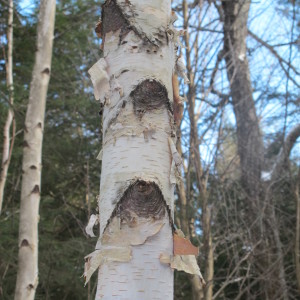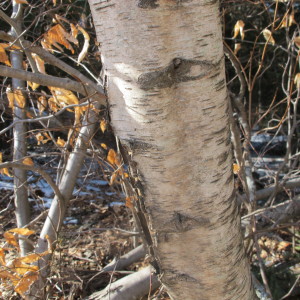Tree Identification
Winter is a slow time for me – there is no weeding or mowing or transplanting to do – so I have time to cross country ski or walk almost every day. I love observing the trees and native shrubs of the forest, and try to know the name of everything I see. Trees without leaves are a bit of a challenge to most of us, but by now I should know almost everything I see, either by tree shape, bark or buds. If you don’t know the woody plants you see in winter, now is a good time to learn them.
I own a number of books that are sold as tree identification books, though most of them try to cover every tree in North America, and can be difficult to use. Last year I got one I really like and sometimes put it in my pack, just in case I see something out of the ordinary. It’s called Forest Trees of Vermont by Trevor Evans. It has detailed information about 82 trees native to Vermont or that have been introduced and are common in the state. Each species has 3 to 6 photos of the leaves, bark, buds, flowers, nuts and sometimes the entire tree, along with descriptions of important characteristics.
There are six species poplars, for example, that grow in Vermont (and presumably throughout New England), but only 4 are native. I know just 2 of the native poplars, the big-toothed poplar (Populus grandidentata) and the quaking aspen (P. tremuloides), and one non-native species, the Lombady poplar (P. nigra) So much for knowing all the trees of the forest. For each genus (a scientific grouping a closely-related plants), there is a chart that summarizes the differences and similarities of each species for their bark, leaves and buds (which are key for winter identification).
An interesting distinction for poplars is the difference in taste of the bark. I’d never read any reference to taste before as a distinguishing characteristic. Quaking aspen has ”very bitter” tasting bark, according to the book, while bigtooth aspen does not. That’s a very useful and easy distinction – from a tree farmer who clearly know his trees. Taste is not a distinguishing characteristic for most groups and is not mentioned, but the odor of twigs is used for cherries and plums. Again, very useful.
The book also has 2 dichotomous keys: one for summer identification, one for winter. In high school biology class I learned to use keys, and find them useful. A key has pairs of observable characteristics. So, for example, a useful distinction is whether a tree has needle-like leaves, or broad leaves. In the first group, all but the tamarack are evergreen. By dividing all trees into 2 those categories, the pool of trees is considerably reduced. In the first group you have pines, cedars, spruce, firs, hemlock and tamarack. Then a second pair of characteristics is used to divide each group into a smaller group, and so on until you find your tree.
Even though, as a well known geezer, I do not have a cell phone, I recognize the utility of including QR codes in the book. For you other geezers and geezerettes, a QR code is a little square with dots that you show your cell phone and, though the wonder of the internet, connects you to a database. In this case there are one or two codes per tree: one taking you to the U.S Department of Agriculture’s NRCS site, another to the Forestry Service site. There is a huge amount of information available there.
Long ago I learned another good distinction: whether leaves and twigs sit opposite each other, or staggered on a branch. There is a mnemonic to help with this: MADCap Horse. That stands for Maple, Ash, Dogwood, members of the group Caprifoliaceae (a group including honeysuckles, viburnums, elderberries and some other shrubs) and horse chestnut – those all have opposite branching. Eeverything else has alternate branching (with minor exceptions, of course).
I should note that the opposite branching distinction is not infallible. For example, a mature sugar maple has many twigs that do not appear to be opposite another. That is because one has fallen off. Look to the top of the tree, where younger twigs are present and you will see opposite pairing.
In winter bark is useful to me for identifying trees. Everyone can probably identify a birch by its whitish bark. But is it a white or paper birch (Betula papyrifera) or a gray birch (B. populifolia)? According to the charts in Forest Trees of Vermont, both have chalky or grayish white bark but gray birch’s bark is “dirty looking”. And paper birch bark separates into “thin horizontal papery layers”, while the gray birch’s bark does not. That should do it. Yellow birch also has papery layers, but the bark is “silvery gray or light yellow”. The book also notes that yellow birch gives off a “wintergreen odor when young branches are scraped”.
Although this book was aimed at Vermont readers, I think it would be useful anywhere in New England. So go for a walk with it or the tree book of your choice, and see what you can identify.
Henry is the author or 4 gardening books. His website is www.Gardening-Guy.com. He lives in Cornish Flat, NH.




